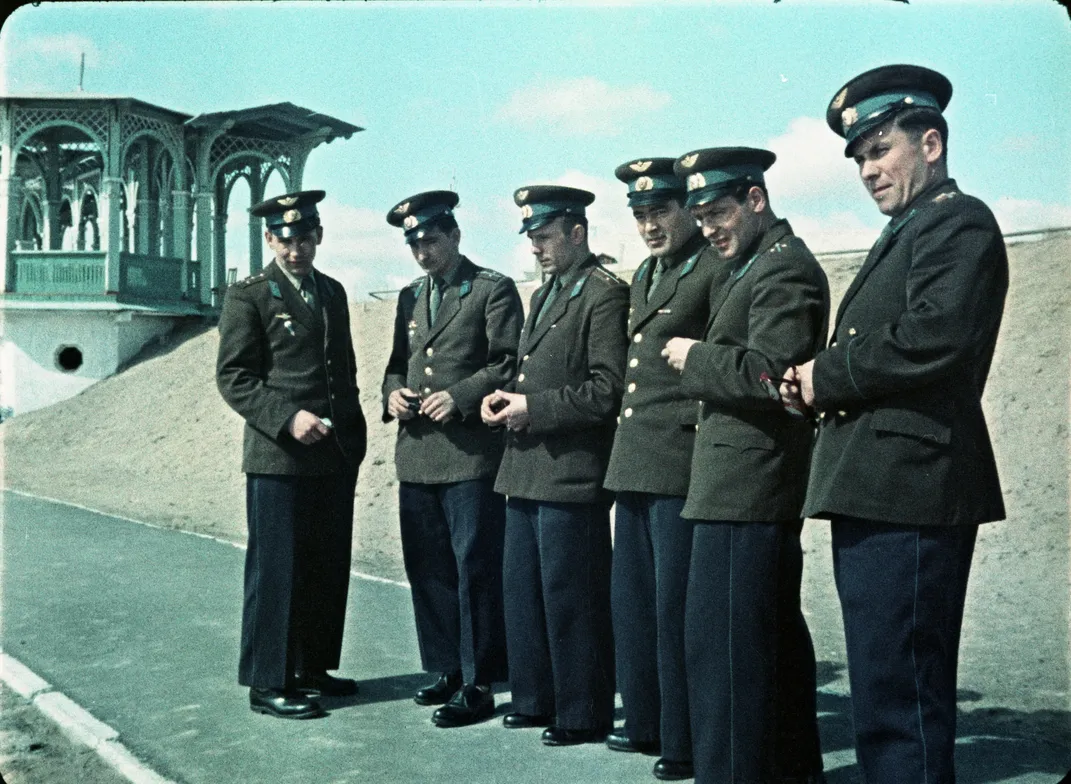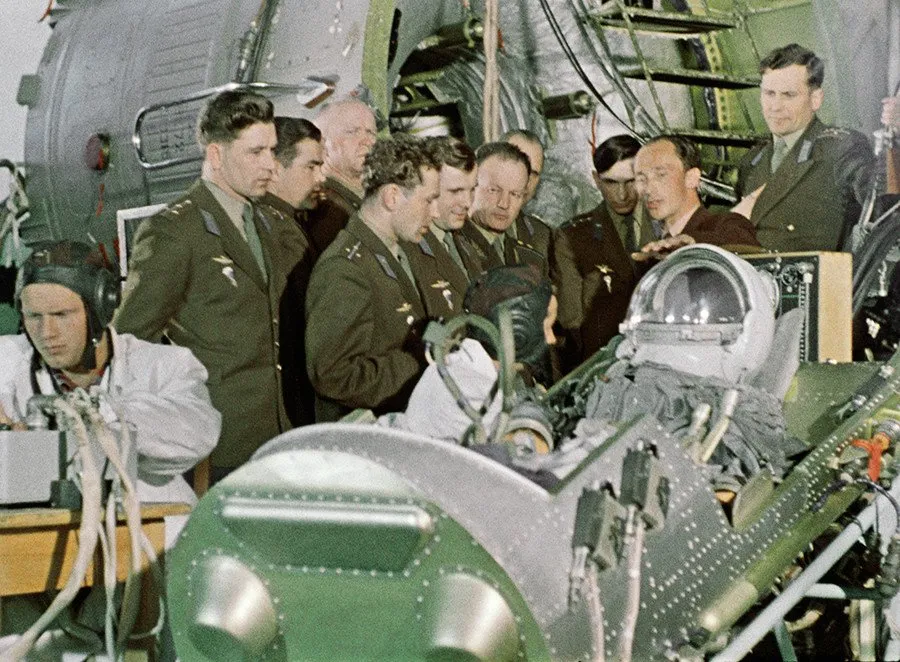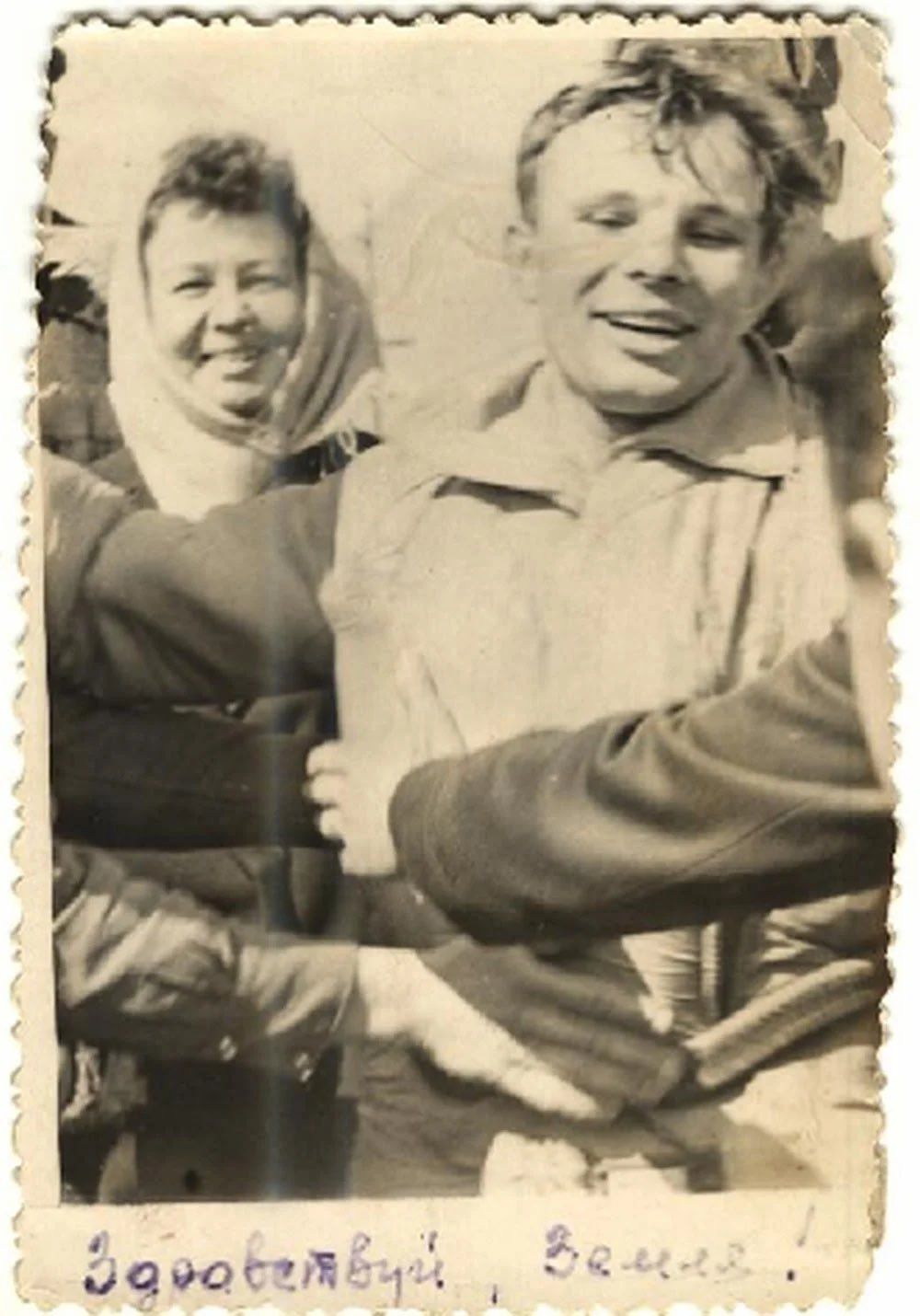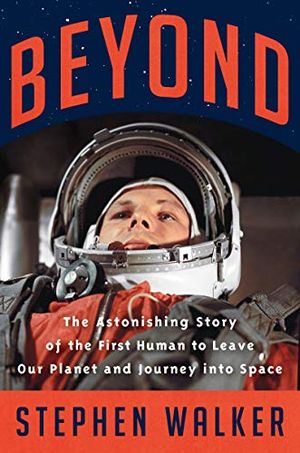How Yuri Gagarin Was Picked to Be First in Space
NASA had the Mercury Seven. The Soviets had the Vanguard Six.
/https://tf-cmsv2-smithsonianmag-media.s3.amazonaws.com/filer/8b/f0/8bf0f603-a68b-49aa-9678-8eb5210cb171/gagarin_before_flight.jpg)
Sixty years ago, early on the morning of April 12, 1961, Soviet air force pilot Yuri Gagarin launched from Kazakhstan on Vostok-1, narrowly beating out American Alan Shepard (by three weeks) to become the first person to travel beyond Earth’s atmosphere into the dark silence of space. Gagarin’s story gets a fresh look in Stephen Walker’s riveting and thoroughly researched new book Beyond, from which the following excerpt is taken.
DEEP IN A birch forest in the Shchyolkovsky District northeast of Moscow, far from the main highway to the city and hidden from prying eyes, stood a small, old-fashioned two-story building half-buried in the snow. Everywhere the snow lay on the ground, even more thickly than it did eight thousand kilometres away in Washington. It had piled on the building’s steeply pitched roof, on the overhanging porch of its front door, and on the tangled branches of the birch trees, accentuating the heavy silence of the forest.
Apart from its curious location, there was nothing especially remarkable about the building itself. Perhaps its very anonymity helped to disguise its true purpose. For this nondescript edifice sitting in the middle of the forest in fact housed one of the most secret institutions in the USSR. Its code name was Military Unit 26266, but it was also known by its initials TsPK or Tsentr Podgotovki Kosmonavtov: the Cosmonaut Training Centre. And it was here on this particular Wednesday, January 18, 1961—two days before President John F. Kennedy’s inauguration in Washington and the day before Alan Shepard’s selection as America’s first astronaut—that six men were competing to be the first cosmonaut of the Soviet Union, if not the world.
Like NASA’s Mercury Seven astronauts in Langley, Virginia, the six men were also sitting in a classroom. But the similarities ended there. They were all obviously younger than the Americans, in their twenties and not thirties. They were all wearing military uniforms, not the casual Ban-Lon shirts favored by the Mercury pilots. And, discounting Gus Grissom, they were all visibly shorter, short enough to fit inside the Vostok spherical capsule replacing the thermonuclear warhead on top of the R-7 missile that they all hoped one day soon to fly in space.
Unlike the Mercury Seven, the Soviet pilots were not expecting an imminent decision on who would fly first. Instead, they were sitting an examination. Later that afternoon they would each be interrogated by a committee responsible for their training. The same committee had already assessed their performance the previous day in a crude simulator of the Vostok capsule. This simulator, the only one in the USSR, was not located in the forest but in a palatial pre-revolutionary building in Zhukovsky on the opposite side of Moscow, codenamed LII and otherwise known as the Gromov Flight Research Institute. For up to fifty minutes, under the watchful eyes of their examiners, each of the six men had practised procedures in the mock-up of the Vostok’s cockpit on the second floor of what had once been a tuberculosis sanatorium under the jurisdiction of the People’s Commissariat for Labour.
The building in the birch forest where the men were now sitting their examinations was the first structure in what would become, over time, a vast, heavily guarded complex closed to the outside world and dedicated solely to the training of the USSR’s cosmonauts. In 1968 it would change its name to Zvyozdny Gorodok—Star City—but that was still far in the future. Until then the area itself was known as Green Village, a nod perhaps to the acres of trees that shrouded it. When the new Cosmonaut Training Centre was established on January 11, 1960, by order of the commander of the Soviet Air Force, Chief Marshal Konstantin Vershinin, Green Village was chosen as the best site for its construction. It had many advantages. It was shielded by its forest but not far from Moscow. It was also only a few kilometres from Chkalovsky air base, the largest military airfield in the Soviet Union. And it was close to OKB-1, the secret design and production plant at Kaliningrad where the Vostok capsules were being built.

The six men had been training for ten months since March 1960, although the classroom building had only been in use since June. They had also used other anonymous centres in Moscow and continued to do so. In years to come, many of them would move into specially built residential blocks in Star City, but in January 1961 they were living near the Chkalovsky air base in basic two-room apartments with their wives and children if they had them, or in even more basic bachelors’ quarters if they did not.
These were a far cry from Alan Shepard’s comfortable house in Virginia Beach’s leafy suburbs or indeed anything the American astronauts and their families would have willingly put up with, but by Soviet standards they were privileged accommodations. Meanwhile nobody in Chkalovsky outside their closed circle knew why the six men were there or what they were training for. Nor did their parents, their friends, or their former colleagues in the air force. Even their own wives were not encouraged to ask too many questions. Unlike the Mercury Seven, who were famous throughout America if not the world, the six men existed only in the shadows.
There was another key difference from the Mercury Seven. These six were not the only cosmonauts being trained. There were another fourteen. In a selection process that was even more ruthless than that undergone by the American astronauts, twenty men had been chosen from an initial pool of almost 3,500 military pilots. The Soviet space programme had ambitions to conquer the cosmos, or at least that part of it encircling the earth, and they needed the manpower to do it. All twenty men had begun their training in the spring of 1960, just two months after Soviet Premier Nikita Khrushchev had urged his chief space engineers that they “should quickly aim for space. There’s broad and all-out levels of work in the USA and they’ll be able to outstrip us.” By then the Mercury Seven had already been training for almost a year. The Soviets needed to catch up quickly and these twenty cosmonauts were the answer. But other than those broad hints in the tightly controlled press about “Soviet men” soon visiting space, the facts would be either hidden or deliberately misrepresented. The rockets, the capsules, the designers, the engineers, the training centres and launch locations, and of course the cosmonauts themselves—all of it would remain behind closed doors.
By the autumn of 1960 the Soviet manned space programme had become a top national goal, not least because back then NASA appeared to be aiming to send an American into space as early as December of that year. To speed things up and prioritise training on the single simulator, a shortlist of six front-runners was filtered from the original twenty. They would fly first, before the others. In essence, they were the premier league team that would take on the Mercury Seven, with the difference being that the Soviets knew about their American rivals, whereas the Americans knew nothing about the Soviets. To those permitted to know, this group of six was given a name. Perhaps in deliberate imitation of the Mercury Seven, they were called the Vanguard Six.

Depending on who’s telling the story, the criteria for selecting the Vanguard Six appears to have been quite different. Dr. Adilya Kotovskaya, a specialist in pathophysiology who supervised centrifuge tests with the cosmonauts, claimed that the men were chosen simply in order of their ability to endure terrific accelerations—similar to those they might one day experience in a rocket launch—without passing out. One of the six, Andriyan Nikolayev, a quiet, heavyset, dour bachelor, proved the most resilient at this. He sailed through Kotovskaya’s crushing centrifuge rides.
Another cosmonaut, Aleksey Leonov, who four years later would execute the world’s first spacewalk, recalls a different rationale behind the selection: It was based entirely on weight and height. As both were critical for the Vostok, only the shortest and lightest men were chosen. Leonov himself was slightly too tall to make the grade. Everybody in this first group had to be under five foot seven. The smallest, at just five foot five, was an open-faced, married twenty-six-year-old former foundry student with blue eyes and a winning smile reminiscent of John Glenn’s. His name was Yuri Gagarin. He too made it to the Vanguard Six.
A third was Grigory Nelyubov. A dark-haired, handsome pilot the same age as Gagarin, Nelyubov was one of the very few among the twenty cosmonauts to have flown the USSR’s first supersonic jet fighter, the MiG-19. Nelyubov possessed a remarkably sharp mind—possibly the sharpest in the entire cosmonaut group—as well as lightning reactions. In some respects he resembled Alan Shepard, including perhaps a tendency to arrogance and a lack of self-criticism that was often noted by his instructors. Some thought him narcissistic. Many actively disliked him. A few believed he would be chosen to fly first. But Nelyubov had not initially been picked for the Vanguard Six. He had replaced another cosmonaut, Anatoly Kartashov, who had been badly injured on Dr. Kotovskaya’s dreaded centrifuge in July 1960. For reasons that were never explained, something had gone wrong and Kartashov was subjected to excessive accelerations as he spun too rapidly around the centrifuge hall. A fellow cosmonaut, Dmitry Zaikin, remembered the result. “The blood vessels in his back,” Zaikin said, “just blew off.” Kartashov was suspended without appeal. Nelyubov was put in his place.
These decisions could be brutal—and final. In the same month as Kartashov’s accident, another original member of the Vanguard Six, Valentin Varmalov, was enjoying a rare day of relaxation in Medvezh’i Ozera, a stretch of shallow lakes near the training centre. With him was Valery Bykovsky, a cosmonaut whose competitiveness was notorious. Varmalov challenged Bykovsky to dive into one of the lakes. Bykovsky took up the challenge at once, grazing his head on the bottom. He cautioned Varmalov. But when Varmalov dived in, he hit the lake bed hard. He was raced to hospital, where he was diagnosed with a displaced cervical vertebra in his neck. He was placed in traction—and suspended from the programme without appeal. Bykovsky stepped into his shoes.

Two other men completed the Vanguard Six. Pavel Popovich was a Ukrainian ex-fighter pilot and by almost all accounts one of the most popular members of the cosmonaut corps. Everybody loved Pavel. His humour was infectious, and he had a terrific sense of fun. “He made you want to live,” said his daughter Natalya, who was four when Popovich sat his cosmonaut exams. If he had an opposite number in the Mercury Seven it would probably have been Walter Schirra, the man who liked playing pranks. Popovich loved singing too, mostly Ukrainian folk songs, and at the drop of a hat he would happily croon in his beautiful baritone the lush, sentimental lyrics he had learned as a child in his tiny village of Uzin near Kiev, including his favourite, “The Night is so Moonlit, so Starry, so Bright”:
The night is so moonlit, so starry, so bright
There’s so much light you could gather the pine needles
Come, my love, weary with toil
If just for one minute to the grove . . .
“We all wanted to be first,” said Popovich years later, just as Alan Shepard and John Glenn had said. But it would take more than love songs for Popovich to become the USSR’s first cosmonaut. Two issues held him back. To begin with, he was Ukrainian, not Russian. Even as the Soviet Union’s propagandists paid lip service to the socialist ideals of ethnic equality, Popovich’s origin was a handicap. The first to go up would have to be a Russian—only nobody would officially say so.
His other issue was his wife. Marina Popovich was a brilliant pilot in her own right who had attempted to join the Soviet air force when she was just sixteen to fly in one of three female pilot regiments that then existed, a state of affairs almost unimaginable in the United States at the time. By 1961 she had already been an outstanding flying instructor for three years. Later she would become one of the USSR’s top test pilots. She was glamorous, beautiful, clever, headstrong, sometimes hot-tempered and also a mother. Taken all together, this was a problem. Lieutenant General Nikolai Kamanin, the chief of cosmonaut training, wrote that Popovich “gives the impression of being tough but is too soft with his wife. Family troubles hold him back.” And, Kamanin added somewhat darkly, “We will take measures to help him.”
Gherman Titov was the final member of the six. A man with movie-star good looks, Titov was athletic, excellent at games and gymnastics, an amateur violinist and a passionate pilot who had graduated with top grades from aviation academy in 1957 and who went on to fly fighter jets in Leningrad. It was there that he met his wife Tamara, who was a waitress at the base cafeteria. They got married within four months. “He was a fighter pilot,” she says. “He did everything fast.”
Born in a log cabin in Siberia, Titov had been brought up by a strict, demanding father who was also the local schoolteacher. His father is said to have named his son Gherman after the lead character in Pushkin’s story “The Queen of Spades,” and the father’s love of Pushkin was comprehensively inherited by the son. Titov could recite whole passages of Pushkin’s works from memory in the same way that Popovich could sing Ukrainian love songs. But his habit of doing it in the middle of training sessions was also guaranteed to exasperate his hard-bitten proletarian instructors. His erudition was both impressive and a liability. He was almost too educated, too bourgeois, too clever, and prone to question rules. Colonel Yevgeny Karpov, who had been appointed to run the training centre, was often driven to distraction by Titov’s resistance to taking orders, especially from doctors like himself. “He would hear the doctors out, then often do things his own way or ignore their instructions altogether,” Karpov said. “When they insisted . . . he became irritated.” But Karpov also admired Titov’s directness and his refusal to invent excuses for himself whenever he got into trouble. It was a constant refrain: hot-headed, sceptical, a man who sometimes broke the rules if he thought they were petty or stupid; but also brilliant, attractive and consistently able. He was another prime candidate for the first flight.
The Titovs lived next door to Yuri Gagarin and his wife Valentina in their Chkalovsky apartment block. The two cosmonauts often spent time with each other, climbing over the partition between their narrow balconies on the fifth floor as the quickest, if not always safest, way to move between apartments. Their friendship deepened later in their training when, in the autumn of 1960, the Titovs’ baby son, Igor, died at the age of seven months from heart complications. Gagarin and Valentina, who had a one-year-old daughter of their own, did everything they could to help the couple cope with a loss so traumatic that Tamara Titova was unable to speak about it to the author almost sixty years later.
In an interview in the 1990s, Titov paid tribute to Gagarin’s warmth and support at that time: “Without being mawkish or sentimental he simply behaved like a truly close and real friend. I was grateful to him and, although I did not know him very well at the time, began to like him a great deal.” As they sat their examinations in January 1961, the bond between the two cosmonauts was very strong, even while they were both competing for the same ultimate prize.

THE FINAL SCORES of the Vanguard Six were awarded the same day that they finished their written papers. All of them were graded “excellent.” Kamanin was one of the examiners. “Who among these six will go down in history as the first person to fly in space?” he wrote in his diary that night. “Who will be the first of them to pay with his life in making this daring attempt?” While making the questionable assumption that the USSR would win the race against the Americans, both sentences betray the implicit paradox at the heart of this adventure: to fly in space was quite possibly to die in space. “There is still,” continued Kamanin in the same entry, after reviewing all the failures of previous Vostok flights with dogs on board, “no guarantee of a safe landing.”
Back in December, in one of many striking parallels with the Mercury Seven, all twenty cosmonauts were asked to vote on which of their peers should fly first. A majority had voted for Yuri Gagarin—one source claims twelve of them did so, another as many as seventeen. But even after these examinations were over and the results known, the decision was still not made. Given the tortuous and often murky hierarchies of Soviet political life, such a decision would anyway have been unthinkable. In Langley, Virginia, Bob Gilruth, head of the Space Task Group responsible for Project Mercury, could summon his seven astronauts into a classroom and tell them, simply and on his own authority, who would be first. Things were done differently in the USSR. Unlike the Mercury Seven, the Vanguard Six would have to wait—and they would have to wait until almost the very last moment.
But even as they waited, unsure which one of them it would be, the examining committee “tentatively,” and without telling the cosmonauts, recommended a ranking. In third place was Grigory Nelyubov. In second place Gherman Titov. And in first place the examiners chose Gherman’s close friend, next-door neighbour and confidant, the winner of the peer vote and the man with the winning smile: Yuri Alekseyevich Gagarin.
Excerpted by permission from Beyond, by Stephen Walker, HarperCollins, 2021. Follow the author on Twitter @SWalkerBEYOND or visit his website at www.stephenwalkerbeyond.com.
A Note to our Readers
Smithsonian magazine participates in affiliate link advertising programs. If you purchase an item through these links, we receive a commission.
